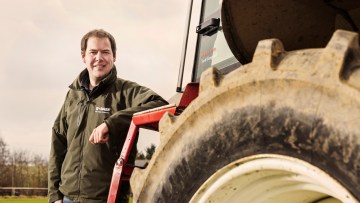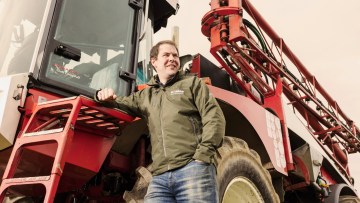RevYstories: Scott Campbell
09.05.2022

About Scott
Scott Campbell is the 4th generation of Campbells farming at Kirkton of Kinellar in Aberdeenshire, the main steading on the 415 ha arable cropping enterprise. The business is split into three roughly similar sized holdings and farmed in partnership with his father and uncle.
Spring barley is his main crop with around 200 ha grown each season for malting, split between different varieties at each holding to spread risk. Winter wheat and oilseed rape make up around a third of his total cropped area, with wheat grown for milling, distilling and feed. Around 22 ha of green manure is grown as part of his existing Agri-Environmental Climate Scheme (AECS), which is sown in May and mulched in August making a good entry for winter wheat.
Winter barley has been dropped in favour of winter oats, which with its later harvest gives around three weeks longer to concentrate on the family’s other enterprise, an excavation business, at a peak time in the summer.
With fertiliser costs soaring, Scott is trying to minimise his risk and exposure to these prices by purchasing anaerobic digestate alongside an existing straw for muck deal.
“All our land at Kirkton and Aquherton gets muck or digestate at least once every four years. The green manure also saves us 20-25% on bagged fertiliser, and we’re also trying some autumn sown cover crops to keep the nutrients in the soil.”
The cover crops are grazed by sheep from local young farmers; encouraging the next generation is important to Scott and he also hosts student visits, practical projects and trials from SRUC Craibstone.
Scott has been involved in the Real Results Circle for two years. He said, “What’s so good about the Real Results is having the opportunity to trial a new product on your farm and in your soil, in a field that you are in every day and know how it can perform. It’s not looking at trial data from 200 miles away.”
Fungicide spend in Scotland does tend to be higher than further south. The wheat varieties with excellent septoria resistance, such as KWS Extase, haven’t suited Scotland, so he grows LG Skyscraper, KWS Lili and Elicit, with a small area this year of RGT Saki. None of them have Septoria resistance ratings much above a five on the SRUC Recommended List, which makes timing crucial in a climate that produces around 800mm of rain a year.

Scott's RevYstory
Last season Scott’s BASF Real Results trials investigated how to use Revystar® XE within his fungicide programmes to maximise crop potential in his winter wheat and spring barley.
Winter wheat
The field of KWS Lili was drilled after oilseed rape and the whole trial received a standard T0.
At T1 the field standard and the BASF standard had 0.75 l/ha Revystar® XE and the Agronomy Max had 1.0 l/ha Revystar® XE. At T2 the Agronomy Max again received the highest rate of Revystar® XE at 1.5 l/ha, with lower rates of 1.0 l/ha for the BASF standard and 0.8 l/ha of very similar actives for the field standard. T3 saw additional pyraclostrobin applied to the Agronomy Max, on top of the trial standard Kestrel® (prothioconazole+ tebuconazole) treatment.
The Agronomy Max tramline yielded 13.29 t/ha yield compared with 12.51 t/ha for his field standard programme and 12.79 t/ha for the standard BASF programme.
The size of the Agronomy Max yield benefit, supported by a visible NDVI benefit as the crop senesced in late July, gives confidence that this was a ‘real’ treatment difference. The Agronomy Max treatment also had higher thousand grain weight and specific weight than the other two treatments.
Scott said, “The Agronomy Max programme cost an extra £52/ha in fungicide but taking 0.78 t/ha extra yield and my average selling price of £190/t that was worth an additional £96.20/ha in margin after taking off the fungicide costs.”
He said, “T2 is the most important spray that we do on the farm- we’ve invested right the way through until flag leaf and we need to keep that investment going so we want something robust, that’s going to last keep the crop clean and green right through to the head spray. We have experience of Revystar® XE (mefentrifluconazole + fluxapyroxad) on our farm at T2 and it did just that, resulting in higher yield and higher bushel weight. Revystar® XE is the cornerstone of a successful T2 for us, with the protection to keep everything clean until T3.”
Spring Barley
In the Real Results LG Diablo spring barley trial, the field treatment consisted of Propel® Xpro (bixafen + prothioconazole + spiroxamine) followed by Imtrex® (fluxapyroxad) + Phoenix® (folpet) at T2.
This was compared with the BASF programme of Priaxor® EC (fluxapyroxad + pyraclostrobin) + Decoy® 250 EC (prothioconazole) at T1 followed by Revystar® XE + Phoenix®. Both programmes had Decoy® 250 EC as a common T3.
The yield results showed the BASF programme yielded over 0.4 t/ha more than the field treatment, with significant treatment effects on green leaf area (GLA) on leaf layers 1 and 2. Because of a lack of replication, ADAS analysis of the results were not able to confirm whether the difference was due to the treatments or underlying variation.
The results have, however, encouraged Scott to use a bit more Revysol® this season. He said, “We might not have got those results over the whole farm, but we will look to use Revysol® and push yields especially on the good bits of land.”
What’s happening on Scott’s Farm?
“This season the crops again have got great potential, they’ve come through the winter well and are looking good. I think potentially yields could be farm average or above. There’s not much to see in terms of disease,” Scott said.
Liquid fertiliser has been applied, taking care to avoid frosts and digestate has been applied, with ploughing well underway. The oilseed rape has suffered a small amount of pigeon damage and pigeons continue to be chased off.
